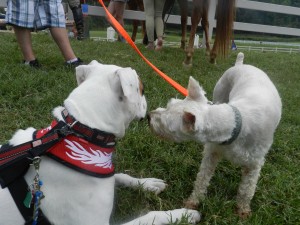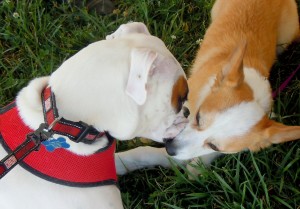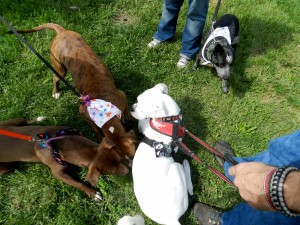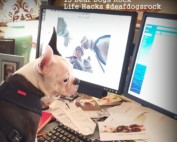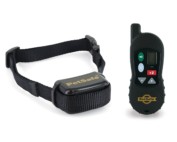I ran across this article about how dogs should greet each other and thought it would give our readers something to think about. Nitro and I do it a little different then this trainer and you may have a certain way you want your dogs to behave when they are socializing or meeting a new dog for the first time. Since Nitro is deaf, and sometimes he doesn’t pick up on certain sounds like a growl for instance, I have taught him to just lay down and chill when he sees another dog approaching. Nitro is a big dog at 80 pounds and he can be pretty intimidating so if it is a large dog he usually will greet the dog with a side to side greeting.
When Nitro sees a small dog, he lays down and patiently waits for the other dog to approach him so he is of no threat to the other dog. So far this method has worked like a charm. Even little scared dogs will approach Nitro. It’s as if Nitro is laying there saying “what ever” to the other dog. By doing this he gives off a calming signal to the other dog. If a dog looks to excited to see Nitro, I will ask the handler of the other dog not to approach. Always be sure to be your dogs advocate in every single situation. What are you doing to make sure your deaf dog stays safe while other dogs approach in a social situation? ~ Christina
(See how good Nitro is laying there chilling with the three dogs greeting him? These three dogs were good canine citizens)
Is there a right way or wrong way for dogs to greet each other? By Julia Levitt founder of In Harmony Dog Training. (from annarbor.com)
Strolling down the street for your morning walk with your trusty canine friend — suddenly your dog spots another dog. You feel your arm being yanked and your pace is rapidly picking up.
Before you know it, your dog is either ferociously barking and lunging at the newcomer, jumping on the person walking the other dog or twisting you and the leash in circles, jumping- playing, or acting in an another inappropriate way toward the new dog.
What happen to my calm tranquil walk?
In her article “The art of learning to Be,” dog trainer Cheri Lucas address this issue:
“Let your dog find his own way socially. Rather than insisting your dog meet face to face, try walking him along side another dog first, when both dogs have settled into a balanced mode they should be allowed to sniff each other. This is the canine version of ‘breaking the ice.’ This method is natural and non-confrontational.”
What is a balanced mode?
“Being able to co-exist in a social setting with other dogs should be acceptable for them as it is for us,” Lucas continues.
“The same thing is true of going to a party. Some people are the so-called ‘life of the party’ and mingle with everyone. Others stay close to the people they know. Some may meet some new people and still stay close to those they know well. The person who doesn’t mingle may be less ‘social’ as a partygoer, but it doesn’t make them any less ‘social’ as a human being. They still socialize with their friends. Think of your dog this way too. If he can just ‘be’ with other dogs, consider him a socialized dog, and don’t pressure him to play with others. If he wants to, he will. But if he is content to sit and have other dogs around without growling or barking, this is good behavior.”
Learning to ‘be’ has us asking a few questions of ourselves:
When I greet a new dog, do I bend down look the dog in the face and begin talking baby talk?
When I see a new dog, and the dog displays excited behavior like jumping or whining, do I foster that behavior by petting the dog ?
Do I go up to the strange dog, stick my hand or closed fist in the dog’s face, and then immediately pet the dog?
Do I say when a strange dog sniffs me, “Oh the dog smells my -dog/cat?”
Do I wait before the owner says it is okay to pet the dog, or do I go right up to the dog and pet it?
A big part of the silent message we send when we greet other dogs is respect for them and the willingness on the human’s part to let a dog come greet us.
One of my friends, Ingrid, walks her two terriers past my excitable Pomeranians. Ingrid stands at a five- or six-foot distance from me while we chat. While we catch up on what is going on in our neighborhood, the dogs, who started out being excited — barking and growling at each other — became quiet and ignored each other. Cheri Lucas would see this as a success.
Julia Levitt is the founder of In Harmony Dog Training (www.inharmonydogtraining.com) in Ann Arbor. She can be reached at julia@inharmonydogtraining.com or at 734-645-4707. Julia provides individual training for dogs and their owners, and also conducts dog training classes at Ann Arbor Animal Hospital.

